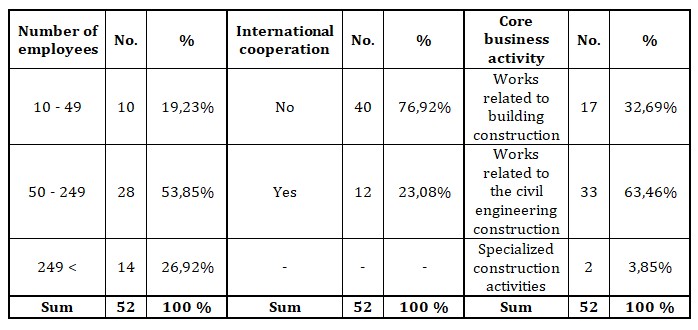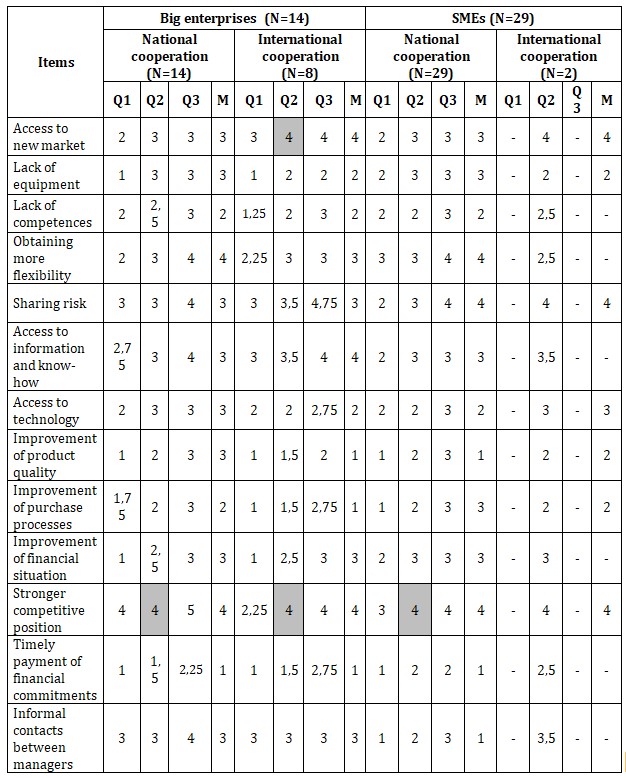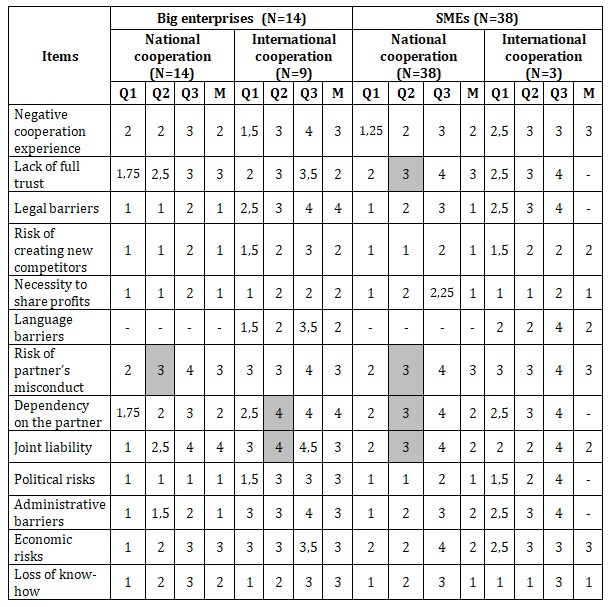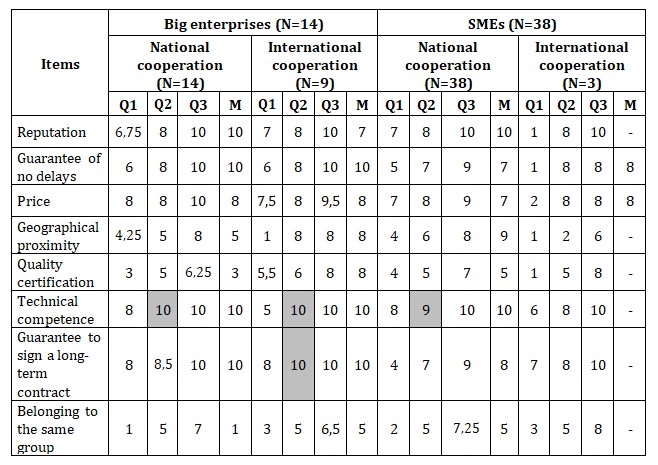Introduction
Nowadays, environmental changes have led to a growing uncertainty and complexity of companies. Cooperation could be the answer for increasing difficulties with planning successful actions (Raetze et al, 2018; Szpitter, 2012), especially in the construction industry, where such factors as timely delivery of a project, its completion within the allocated budget and an effective coordination between parties determine whether the project is a success or not (Vijayabanu and Vignesh, 2018). Projects promote cooperation (Raetze et al, 2018) – many parties are involved in construction project: designers, clients, subcontractors and contractors, suppliers of construction equipment and materials (Alinaitwe and Ayesiga, 2013; Welling and Kamann, 2001). Construction industry’s projects often have international level. For example, Damjanović et al (2017) point, that the majority of investments in Serbia comes from foreign countries, e.g. UE countries, such as Germany, Sweden, Italy or France. Problem of international cooperation is crucial, especially for small and medium sized enterprises (SME). Cooperation might be extremely beneficial for this sector, which often has to deal with insufficient resources (Gélinas and Bigras, 2004; Brzostek and Michna, 2016). By participating in interfirm networks, SMEs have a chance to gain access to resources like new knowledge and skills. What is more, the topic of SMEs’ internationalization is still up-to-date, since SME operations are crucial for the performance of national economies (Jankowska, 2015; Michna, 2018; Kmieciak et al, 2018). The SME sector, as well as the construction industry, plays an important role in shaping the economy, influencing, among other things, the Gross Domestic Product (GDP) and employment (A recovery on…, 2013; Michna et al, 2017; Nistorescu and Ploscaru, 2010; Söllner, 2014). Moreover, the construction industry is one of the most important sectors of economy which contributes towards the fiscal expansion of any country (Vijayabanu and Vignesh, 2018). The expansion of a business, in order to enter international markets, increases its importance in modern economy (Daszkiewicz, 2008; Głód, 2012). The presented research is a part of an examination of the relationship between cooperation and performance of SME in the construction sector. Previous research of Polish SMEs from the construction industry of the Silesia region indicates that those companies mainly cooperate with German enterprises as their foreign partners (Czerwińska-Lubszczyk and Michna, 2016). Statistical data confirm that the largest percentage of construction production carried out abroad by Polish enterprises is located in Germany (43.94%), thus, it is fair to say that Germany is the main partner of Polish construction enterprises in international market (Budownictwo – wyniki działalności…, 2014). It seems justified to conduct research in Germany as well. It could be interesting to examine the selected aspects of inter-organizational cooperation, such as barriers of cooperation, motivation to cooperate or desirable partner attributes. That may allow Polish entrepreneurs to recognize the preferences of German partners.
The main purpose of this paper is to examine the selected aspects of interfirm cooperation with German construction companies, the main business partner of Polish SME from construction sector. Motivation to cooperate, barriers of cooperation and desirable attributes of a partner were chosen, due to the international context of the research.
Theoretical background
Cooperation
Doucette and Wiederholt (1997) define cooperation as “the process in which firms pursue their own goals and thus retain autonomy, while at the same time orienting their actions towards joint outcomes” (Sengün and Wasti, 2011). Cooperation can have a national or international dimension. Welch and Luostarinen (1988) defined internationalization as “the process of increasing involvement in international operations” (Jankowska, 2015). Internationalization may manifest itself in various forms, such as export and import, foreign direct investments, international subcontracting and international cooperation.
SMEs and the construction industry
Enterprises could be divided according to the UE law. According to Annex 1 to the Commission Regulation (EU) No 651/2014 of 17 June 2014, declaring certain categories of aid compatible with the internal market, in application of Articles 107 and 108 of the Treaty Text with EEA relevance: „The category of micro, small and medium-sized enterprises (‘SMEs’) is made up of enterprises which employ fewer than 250 persons and which have an annual turnover not exceeding EUR 50 million, and/or an annual balance sheet total not exceeding EUR 43 million” (Commission Regulation (EU)…).
The construction industry could be classified by NACE Rev. 2. Statistical Classification of Economic Activities in the European Community – statistical classifications of economic activities developed in 1970 by the European Union. Section F (construction) is further divided into three sub-divisions: construction of buildings, civil engineering and specialized construction activities (NACE Rev. 2…).
Motivation to cooperation
Inter-organizational cooperation is the subject of numerous empirical studies. It is frequently considered by researchers to be the source of growth and performance of enterprises (Lechner et al, 2006; Maldonado-Guzmán et al, 2012; Schoonjans et al, 2013). Statistical evidence on innovation shows that larger companies tend to cooperate more than SMEs. However, SME “may be more dependent on external links and external resources, because cooperation would act as a mechanism to compensate for size-inherent competitive disadvantages” (Fernández-Ardevol and Masllorens, 2011). Cooperation in the construction industry could improve enterprise’s competitiveness, improve product quality and help keep pace with the changing customer requirements (Ansah et al, 2016; Nakhaei et al, 2017). Internationally cooperating enterprises can gain “access to valuable resources, such as knowledge about foreign markets and the methods of operating in these markets” (Jankowska, 2015).
Beuve and Saussier (2011) indicate motivators behind interfirm cooperation in strategic relationships. They mention such motivators as: access to a new market, securing a return on investment, compensating for lack of equipment or competences, obtaining more flexibility, refocusing on the primary business (Beuve and Saussier, 2011). Fernández-Ardevol and Masllorens (2011) identify factors that indicate the main reasons behind engaging in science-based cooperation. From the point of view of an SME, three main motivations to cooperate are mentioned: lack of internal resources, sharing risk and search for complementarity. Danik and Lewandowska (2013) mention several motivators in the field of cooperation in the engineering industry, with particular emphasis on: improvement of product quality, better access to final markets, improvement of production and purchase processes, improvement of R&D, improvement of financial situation, scale effect, unused production capacity, stronger competitive position, marketing improvement, increase of product range, decline of local demand, the need to internationalize and informal contacts between managers. The results show the most important motives of cooperation: access to final markets, improvement of product quality and improvement of production processes. Authors concluded, that the surveyed enterprises “from the engineering industry, eager to enter international markets, on the one hand rely, to a high extend, on their competitive strategies towards innovations, in order to maintain their cost/price competitive advantage, and on the other hand, they do make efforts to compete based on product quality” (Danik and Lewandowska, 2013).
Barriers of cooperation
International cooperation is very difficult to maintain, due to the barriers. Empirical research on a cross-border project (impact of IPA 2007-2013 CBC Bosnia and Herzegovina-Serbia Programme) on international cooperation and strengthened competitiveness of the participating SME companies – confirm that “there are no further significant cross-border cooperation activities after project implementation”. Enterprises were satisfied with the project activities and the achieved result, but it did not increase the cross-border cooperation (Jaganjac et al, 2018). According to Seppo (2007), interfirm networks can accelerate internationalization, due to de fact that enterprises can get the information about foreign markets from their partners. However, it was noted that conflicting interests, values and objectives of network members can be a barrier (Jankowska, 2015). Danik and Lewandowska (2013) indicate such barriers in the field of cooperation in engineering industry as: negative cooperation experience, lack of full trust, legal barriers, risk of creating new competitors, necessity to share profits, language barriers and lack of need for cooperation. The general results indicate that the most influential cooperation barriers are: negative cooperation experience, lack of full trust and legal barriers (Danik and Lewandowska, 2013).
Desired attributes of a partner
Beuve and Saussier (2011) indicate the criteria used to select the partner for cooperation: reputation, guarantee of no delays, price, geographical proximity, quality certificates, technical competence, guarantee to sign a long-term contract and belonging to the same group of enterprises. Reputation can be a substitute for costly mechanisms, which verify the intentions and monitor the actions of partners, so it is often considered as a source of increased interfirm cooperation (Beuve and Saussier, 2011). In the case of construction projects, cost is often one of the major indicators. Regardless of any construction project, financial measures occupy predominant place in achieving the success. Every construction project should be expected to be completed within the budget (Vijayabanu and Vignesh, 2018).
Methodology
On the basis of literature review, a set of items was developed: motivation to cooperation, barriers of cooperation and desired attributes of a partner. Those items were left unchanged (only translated into German) or modified for the research purposes. Research tools included dividing organizations into national and foreign entities, which allowed measuring the differences between national and international cooperation. The question about the motivation for cooperation was built on the basis of three publications: Beuve and Saussier (2011); Fernández-Ardevol and Masllorens (2011); Danik and Lewandowska (2013). Barriers of cooperation were measured based on the work of Danik and Lewandowska (2013); desired attributes of a partner – based on the paper of Beuve and Saussier (2011). Each item of motivation and barriers was measured on a five-point scale. Desired business partner’s attributes were measured on a ten-point scale. Respondents marked their answers for national and foreign organizations.
The participants of the research were construction enterprises from Germany (Walther, 2015). An on-line questionnaire was used to survey the enterprises. The survey took place in the summer of 2014. Altogether, 748 German building companies were contacted and asked to participate in the survey – thus, 748 questionnaires were distributed. Of those, 52 surveys have returned and qualified for evaluation. Among 52 enterprises, 12 cooperated with foreign organizations. These 12 enterprises completed a double questionnaire, i.e. in the context of both domestic and international cooperation.
Table 1: Sample structure by number of employees, international cooperation and
Core business

The 19,23% of the investigated enterprises were small, 53,85 % were medium sized and 26,92% were big enterprises (table 1). Considering the dominant business activity: 32,69% of companies deal with construction of buildings, 63,46% – specialized in construction activities and 3,85% – civil engineering. Only 23,08% of the surveyed enterprises cooperate with foreign partners – in the European Union and outside of the EU. Those companies mentioned: Poland (N = 5), Czech Republic (N = 4), Netherlands (N = 4), Great Britain (N = 3), United Arab Emirates (N = 2) and others (e.g. Austria, China, Denmark, Israel, Romania, Russia, USA) as their foreign partners.
Results
Data analysis focused on quantitative methods. Tables 2, 3 and 4 present results in the field of motivation for cooperation, barriers of cooperation and desired business partner attributes. First and third quartile, medians and mode (M) were applied to analyze the data. The results (in tables) were analyzed by the size of investigated enterprises (SMEs and big enterprises) and the range of cooperation (answers for national and international cooperation). Due to the number of SMEs that cooperate internationally, authors did not analyze this part of the results (international cooperation for SMEs). The highest medians have been marked in column. The major motivation for cooperation (the highest median) for big enterprises, in the national market, is stronger competitive position, while in the international market, access to new market, as well as stronger competitive position (table 2). SMEs emphasize stronger competitive position in the national market as the major motivator. For those motivators: stronger competitive position (for big enterprises in national and international market; for SMEs in national market) and access to new market (for big enterprises in international market), there are four modes, so it is the value that occurred most often. A comparison of median values for items of motivation in the national market between SMEs and big enterprises shows similar level in total. The major barriers of cooperation (the highest median) for big enterprises in the national market are (table 3): the risk of partner’s misconduct (Mode=3); in the international market: dependency on the partner (Mode=4) and joint liability (Mode=3). The major barriers of cooperation for SMEs have wider range than for big enterprises. In the national market, SMEs emphasize the lack of full trust (Mode=3), risk of partner’s misconduct (Mode=3), dependency on the partner (Mode=2) and joint liability (Mode=2). A comparison of median values for barriers of cooperation in the national market between SMEs and big enterprises shows similar level for all barriers (but slightly higher values for SMEs). Median results for barriers in the international market are visibly higher than for national cooperation (big enterprises).
A comparison of median values for motivation and barriers shows: higher marks for motivation than for barriers in the national market for both groups of enterprises: SMEs and big companies.
Table 2: Results for the motivation for cooperation

Table 3: Results for barriers of cooperation

Table 4: Results for desired business partner’s attributes

The major desired business partner’s attributes (the highest median) for big enterprises in the national market are: technical competence, while in the international market: guarantee to sign a long-term contract, as well as technical competence (table 4). SMEs emphasize technical competence as a major motivator in case of domestic partners for cooperation.
For those attributes: technical competence (for big enterprises in the national and international market; for SMEs in the national market) and guarantee to sign a long-term contract (for big enterprises in the international market) modes are 10.
Discussion and conclusions
The operation of SME (e.g. due to their limited access to resources) and business reality of construction companies, i.e. participation in tenders or implementation of projects, requires cooperation.
This study allowed the Authors to examine the selected aspects of interfirm cooperation of German building companies: motivation to cooperate, barriers of cooperation and desired attributes of a partner.
On the basis of this study, it could be concluded that:
- The major motivation for cooperation for big enterprises in the national market is a stronger competitive position;
- The major motivations for cooperation for big enterprises in the international market are the access to new market and a stronger competitive position;
- The major motivation for cooperation for SMEs in the national market is stronger competitive position;
- SMEs and big enterprises have similar level of motivation towards cooperation (national market);
- The major barrier for cooperation for big enterprises in the national market is the risk of partner’s misconduct;
- The major barriers for cooperation for big enterprises in the international market are:dependency on the partner and joint liability;
- The major barriers for cooperation for SMEs in the national market are: lack of full trust, risk of partner’s misconduct, dependency on the partner and joint liability;
- Barriers in the international market are visibly higher than for the national cooperation of big enterprises;
- SMEs and big enterprises are affected by barriers of cooperation on a similar level – but slightly higher for SMEs (national market);
- SMEs and big enterprises have higher level of motivation to cooperation than the level of barriers of cooperation (national market);
- The major desired business partner’s attribute for big enterprises in the national market is technical competence;
- The major desired business partner’s attributes for big enterprises in the international market are: guarantee to sign a long-term contract and technical competence;
- The major desired business partner’s attribute for SMEs in the national market is technical competence.
The main purpose of this paper is to examine the selected aspects of interfirm cooperation of German building companies – main business partners of Polish SME from construction sector. The results of this study show the preferences of German construction partners in context of cooperation.
In the context of motivation for cooperation, German big enterprises focus on the access to new market and strengthening their competitive position. They fear dependency on the partner and joint liability. It appears that joint liability is a crucial problem for cooperation between building companies. It can be important for every participant of the project and tenders. “The main contractor is liable for the misconduct of the subcontractor in Germany. If, for example, the subcontractor does not pay social security contributions, premiums for the statutory accident insurance or minimum wage, the main contractor is liable for outstanding payments” (Czerwińska-Lubszczyk et al, 2015). Good relationship between partners may decrease the negative influence of this barrier. Polish construction companies should also ensure that the participants are equal partners of international cooperation.
Desired business partner’s attributes are: guarantee to sign a long-term contract and technical competence. In the context of previous research, Polish companies do not pay much attention to such attributes as the possibility to sign a long-term contract and technical competences. Polish SMEs from the construction industry rather focus on reputation and price (Czerwińska-Lubszczyk et al, 2015). In case of cooperation with German partners, they should pay particular attention to assure their high qualification in technical meaning and ensure a possibility to sign a long-term contract.
Limitations and guidelines for further research
This study has some limitations that may be addressed by future studies. First, in this research, an error was identified in the on-line research tool, which resulted in the lack of some answers for motivation: national cooperation (N=9) and international cooperation (N=2). Secondly, this study focused on three dimensions of interfirm cooperation in the construction industry. However, it would be unwise to claim that this list is complete; thus, future research should include additional factors.
Thanks to this research, authors might identify German companies from the construction industry which cooperate with Polish partners. The next step is to conduct qualitative research on international cooperation between Polish SMEs and German companies from the construction industry.
Despite that the inter-organizational cooperation is the subject of numerous empirical studies (Cabras and Pearson, 2014; Kamnungwut and Guy, 2012), the problem might be very interesting on an industrial (sector) level. However, SMEs in the construction sector have their own characteristics and, as such, the results of previous empirical studies conducted in other sectors might not apply to them (Michna et al, 2015). Furthermore, Jankowska (2015) states a question about the internationalization of SMEs in Poland: “Are pro-internationalization actions necessary?” Referring to data from the Polish Agency for Enterprise Development (Polska Agencja Rozwoju Przedsiębiorczości), related to the level of internationalization of SMEs in Poland, she answers that “pro-internationalization actions are needed” (Jankowska, 2015). It seems that the investigation on international cooperation of Polish SMEs from the construction industry with foreign partners (especially with German partners) is needed.
Acknowledgment
The authors are grateful to Univ.-Prof. Dr.-Ing. Dipl.-Kfm. Dieter JACOB and Martina WALTHER, M. Sc. (Technische Universität Bergakademie Freiberg) for the cooperation in collecting valuable data concerning cooperation of the German construction industry.
(adsbygoogle = window.adsbygoogle || []).push({});
References
- A recovery on the horizon? Annual report on European SMEs 2012/2013 (2013), European Commission.
- Alinaitwe, H. and Ayesiga, R. (2013), ‘Success Factors for the Implementation of Public-Private Partnerships in the ConstructionIndustry in Uganda,’ Journal of Construction in Developing Countries, 18 (2), 1-14.
- Ansah, SK., Awere, E. and Edu-Buandoh, KBM. (2016), ‘Relevance of Partnering as an Alternative Approach to Management of ConstructionProjects in Ghana,’ Journal of Education and Practice, 7 (14), 141-149.
- Beuve, J. and Saussier, S. (2011), ‘Interfirm Cooperation in Strategic Relationships: The Role of Formal Contract,’ Industrial and Corporate Change, 21 (4), 811-836.
- Brzostek, K. and Michna, A. (2016), ‘Empirical Research on the Relationship Between Knowledge Management, Market Orientation and Small and Medium-Sized Enterprises Performance – Selected Preliminary Results,’ Proceedings of the 4th International Conference Innovation Management, Entrepreneurship and Corporate Sustainability, 26-27 May 2016, Prague, Czech Republic, 66–76.
- Budownictwo – wyniki działalności w 2013 r. (2014), GUS, Warszawa.
- Cabras, I. and Pearson, M. (2014), ‘Innovation and Connectivity in Northern European Technical Cooperation Networks,’ International Journal of Innovation Management, 18 (4), 1-24.
- Commission Regulation (EU) No 651/2014 of 17 June 2014 declaring certain categories of aid compatible with the internal market in application of Articles 107 and 108 of the Treaty Text with EEA.
- Czerwińska-Lubszczyk, A., Michna, A., Schleuder, F. and Walther, M. (2015), ‘The Comparison of Polish and German Construction Companies in the Context of Chosen Aspects of Inter-Organizational Cooperation,’ Zeszyty Naukowe Politechniki Śląskiej. Organizacja i Zarządzanie, z. 80, 83-98.
- Czerwińska-Lubszczyk, A. and Michna, A. (2016), Cooperation of SMEs in Building Sector in National and International Context – Preliminary Research Findings, Zarządzanie Współczesnym Przedsiębiorstwem. Uwarunkowania, trendy, perspektywy, Sroka, W. (ed.), Wydawnictwo „Dom Organizatora”, 282-292.
- Damjanović, A. , Minić, M. and Milovanović S., (2017), ‘Analysis of Public-Private Partnership Projects in Serbia,’ Megatrend Review, 14 (1), 117-131.
- Danik, L. and Lewandowska, M. (2013), ‘Motives and Barriers in the Field of Cooperation Between Companies. Research Outcomes Based on the Polish Engineering Industry,’ Journal of Economics and Management, 14, 21-34.
- Daszkiewicz, N. (2008), Konkurencyjność małych i średnich przedsiębiorstw w procesie internacjonalizacji, Konkurencyjność. Poziom makro, mezo i mikro, Daszkiewicz, N. (ed.), Wydawnictwo Naukowe PWN, Warszawa.
- Fernández-Ardevol, M. and Masllorens, J. L. (2011), ‘Determinants of Science-Based Cooperation: Evidence in a Sample of Small and Micro Firms,’ Managing Global Transitions, 9 (4), 319-333.
- Gélinas, R. and Bigras, Y. (2004), ‘The Characteristics and Features of SMEs: Favorable or Unfavorable to Logistics Integration?,’ Journal of Small Business Management, 42 (3), 268-278.
- Głód, W. (2012), Strategie umiędzynarodowienia MŚP i ich uwarunkowania – wyniki badań, Strategie rozwoju organizacji, Stabryła, A. and Małkus, T. (ed.), Mfiles.pl, Kraków 2012.
- Jaganjac, J., Obhodžaš, I. and Jovanović, SV. (2018), ‘Improving SMEsCross-Border Cooperationby Upscaled Program Management, International Journal of Sales,’ Retailing & Marketing, 7 (1), 50-61.
- Jankowska, B. (2015), ‘Cluster Organization as a Pro-Internationalization Form of Cooperation in the SME Sector – a Polish Case in the European Context,’ Journal of Economics and Management, 22 (4), 54-75.
- Kamnungwut, W. and Guy, F. (2012), ‘Knowledge in the Air and Cooperation Among Firms: Traditions of Secrecy and the Reluctant Emergence of Specialization in the Ceramic Manufacturing District of Lampang, Thailand,’ Environment and Planning, 44 (7), 1679-1695.
- Kmieciak, R., Michna, A. and Felden, C. (2018). ‘A Comparison of Information Technology Capability, Employee Empowerment and Innovativeness in German and Polish Firms,’ Journal of East European Management Studies JEEMS, 23(4), 642-672.
- Lechner, C., Dowling, M. and Welpe, I. (2006), ‘Firm Networks and Firm Development: The Role of the Relational Mix,’ Journal of Business Venturing, 21(4), 514-540.
- Maldonado-Guzmán, G., González-Campo, C. H. and Galvez-Albarracín E. J. (2012), ‘Co–operation as a Marketing Strategy in Mexico’s SMEs: An Empirical Evidence,’ Revista de Globalización, Competitividad & Gobernabilidad, 6 (2), 16-28.
- Michna, A., Kmieciak, and Burzyńska-Ptaszek, K. (2017), ‘Job Preferences and Expectations of Disabled People and Small and Medium-Sized Enterprises in Poland: Implications for Disabled People’s Professional Development,’ Human Resource Development Quarterly, 28 (3), 299-336.
- Michna, A., Kmieciak, R. and Czerwińska-Lubszczyk, A. (2015), ‘Interorganizational Relationships and Performance of SMEs in the Construction Sector: Past Research and Future Directions,’ Aspekte der Baubetriebslehre in Forschung und Praxis, Kessel, T., Gawlitta, M., Hilbig, C. and Walther, M. (ed.), Springer Gabler, 129-146.
- Michna A. (2018), ‘The Mediating Role of Firm Innovativeness in the Relationship Between Knowledge Sharing and Customer Satisfaction in SMEs,’ Engineering Economics, 29 (1), 93– 103.
- NACE Rev. 2. Statistical Classification of Economic Activities in the European Community (2008), European Commission, Luxembourg.
- Nakhaei, M., Bandaryan, E. and Ezatpanah, B. (2017), ‘Public and Private Partnership: A Strategy to Repair Old Texture,’ Journal of History, Culture & Art Research / Tarih Kültür ve Sanat Arastirmalari Dergisi, 6 (1), 532-548.
- Nistorescu, T. and Ploscaru, C. (2010), ‘A Strategic Approach of the Construction Sector in Romania,’ Annals of the University of Petrosani Economics, 12 (1), 193-204.
- Raetze, S., Geithner, S. and Fassauer, G. (2018), ‘Demands, Stressors, and Resources inCo–Configured Project Work: Case Study of a ConstructionCompany,’ Management Revue, 29(1), 5-31.
- Schoonjans, B., van Cauwenberge, P. and Vander Bauwhede, H. (2013), ‘Formal Business Networking and SME Growth,’ Small Business Economics, 41 (1), 169-181.
- Sengün, A. E. and Wasti, S. N. (2011), ‘Trust Types, Distrust, and Performance Outcomes in Small Business Relationships: The Pharmacy-Drug Warehouse Case,’ The Service Industries Journal, 31(1-2), 287-309.
- Söllner, R. (2014), ‘The Economic Importance of Small and Medium-Sized Enterprises in Germany,’ WISTA – Scientific Journal, 1, Federal Statistical Office.
- Szpitter, A. (2012), ‘Innowacyjne Podejście do Zarządzania Projektami,’ Przegląd Organizacji, 1, 10-13.
- Vijayabanu, C. and Vignesh, T. (2018), ‘Critical Factors Determining the Success of Public-Private Partnership in ConstructionProjects: An Indian Context,’ Journal of Modern Project Management, Jan-Apr, 24-39.
- Walther, M. (2015), ‘Cooperation in the Form of Consortia – Evaluation of Risks, Opportunities and Criteria for the Selection of Business Partners,’ Zeszyty Naukowe Politechniki Śląskiej. Organizacja i Zarządzanie, z. 82, 311-327.
- Welling, D. T. and Kamann, D. J. F. (2001), ‘Vertical Cooperation in the Construction Industry: Size Does Matter,’ Journal of Supply Chain Management, 37 (3), 28-33.







